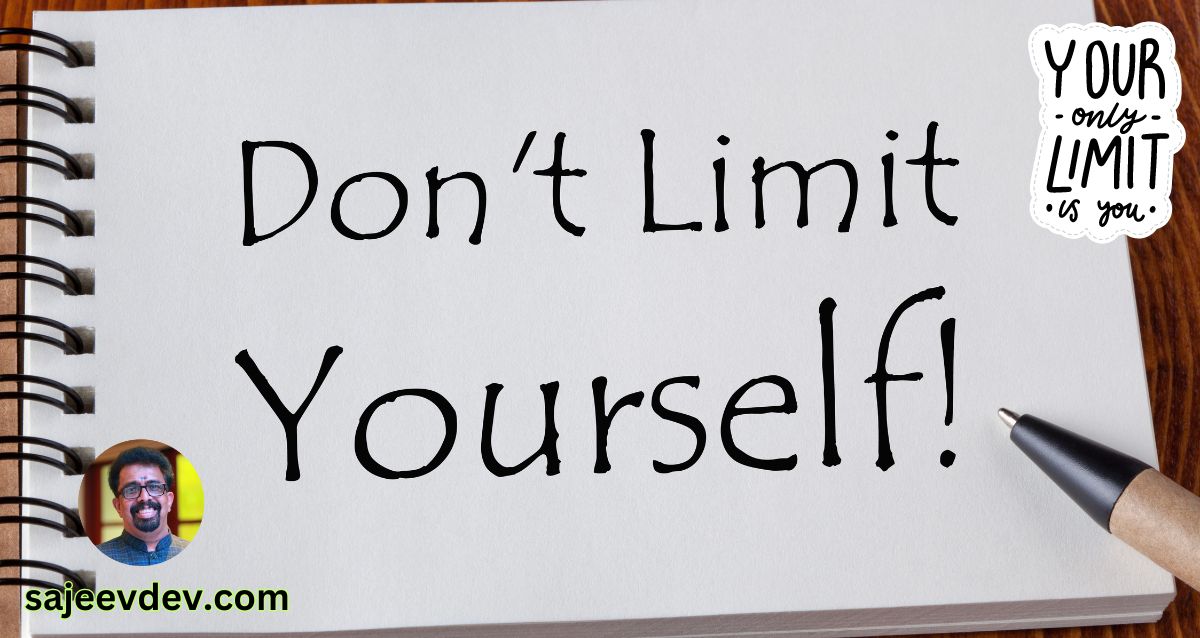Self-imposed limitations are detrimental constraints that individuals place upon themselves, often stemming from deeply rooted beliefs, fears, and doubts
Self-imposed limitations are detrimental constraints that individuals place upon themselves, often stemming from deeply rooted beliefs, fears, and doubts. These limitations can manifest in various aspects of life, including personal relationships, career aspirations, and self-image. For instance, an individual might believe they are not capable of pursuing their dream job due to feelings of inadequacy or a history of failure. Such beliefs can create a mental barrier that prevents one from taking action or seizing opportunities.
In many cases, these obstacles are not inherently real but are instead fabricated by our own minds. When we internalize negative thoughts or societal expectations, we inadvertently hinder our potential. The voices of self-doubt and criticism can be powerful, leading to a cycle of avoidance and resignation. This cycle only reinforces the belief that we are not worthy or capable, further entrenching us within the confines of our self-imposed limitations.
Recognizing these limitations is a critical step in the process of breaking free from them. By examining the origins of our beliefs, we can begin to deconstruct the narratives that hold us back. This includes questioning the validity of these beliefs and understanding how they impact our decision-making and overall well-being. The path to self-discovery requires introspection and the willingness to confront uncomfortable truths about our thoughts and behaviors.
Identifying self-imposed limitations is not merely an intellectual exercise; it is a vital component of personal growth. Gaining awareness of the barriers we create allows us to challenge and ultimately overcome them. By embracing our infinite potential, we can transform our lives and achieve aspirations that once seemed unattainable. The journey towards self-liberation begins with this understanding, paving the way for a more fulfilling and empowered existence.
The Psychology Behind Limiting Beliefs
Limiting beliefs are cognitive constructs that can significantly hinder personal development and achievement. These beliefs often originate from various psychological factors, including childhood experiences, societal expectations, and individual insecurities. Understanding the psychology behind these limiting beliefs is crucial for anyone looking to embrace their full potential.
During childhood, formative experiences play a pivotal role in shaping an individual’s self-perception. For instance, negative feedback from authoritative figures, such as parents or teachers, can lead to internalized beliefs about one’s abilities. A child who is consistently told they are not good enough may grow into an adult who doubts their competencies, ultimately restraining their ability to pursue ambitious goals. This process illustrates how early experiences can engrain limiting beliefs deep within one’s psyche, affecting decision-making and self-esteem later in life.
Societal expectations also contribute to the development of limiting beliefs. Social norms and cultural narratives often establish certain benchmarks for success, creating implicit pressures to conform. Individuals may feel compelled to adhere to these standards, which can result in self-imposed constraints. When people measure their worth against these societal constructs, they may overlook their unique strengths, thereby perpetuating feelings of inadequacy.
Furthermore, personal insecurities often amplify limiting beliefs. Many individuals harbor doubts about their capabilities, which can stem from comparison with peers who seem more successful or confident. This comparison breeds a fixed mindset, wherein one becomes reluctant to embrace change or take risks, further entrenching these limiting beliefs. The connection between personal insecurities and self-image reinforces a cycle of self-doubt that can significantly impede growth.
By critically examining the origins and influences of limiting beliefs, individuals can take proactive steps toward reframing their mindset, thus unlocking their infinite potential.
Identifying Your Own Limitations
Recognizing and identifying self-imposed limitations is an essential first step toward personal growth and unleashing your infinite potential. Limiting beliefs often remain hidden, influencing decisions and actions subconsciously. To uncover these limitations, one effective method is journaling. Set aside time each day to write about your thoughts and experiences. Focus on moments when you felt constrained or held back. Write about the emotions you experienced and the circumstances that triggered such feelings. This reflective practice can help reveal recurring themes that point to limiting beliefs.
In addition to journaling, self-reflection plays a critical role in identifying limitations. Allocate time for solitude, where you can engage in deep thought regarding your aspirations and fears. Ask yourself probing questions such as: “What are my fears that prevent me from taking risks?” or “What do I believe I am incapable of achieving?” Through honest self-examination, you can begin to isolate specific beliefs and attitudes that may hinder your progress.
Another valuable strategy is seeking feedback from trusted individuals. Sometimes, external perspectives can provide insights that we might overlook. Approach friends, family members, or colleagues and ask them to share their observations about your behaviors or decisions. Encourage them to be candid, as constructive criticism can illuminate patterns you may not recognize in yourself. Be open to this feedback to maximize its efficacy. Engaging in conversations about your aspirations and perceived obstacles can further clarify your understanding of self-imposed limitations.
By incorporating these practices—journaling, self-reflection, and seeking feedback—you can effectively identify and confront the beliefs that hold you back. This process of awareness is crucial as it empowers you to redefine your limits and embrace your full potential.
Challenging Your Beliefs: Strategies for Change
Challenging self-imposed limitations begins with an examination of one’s beliefs. These beliefs often dictate our experiences and can significantly restrict our potential. To reshape these beliefs, various strategies can be employed that promote a mindset shift from limitation to possibility.
One effective method is cognitive restructuring, which involves identifying irrational or negative thoughts and reframing them in a more positive light. This technique encourages individuals to question the validity of their beliefs. For instance, if one believes, “I am not capable of achieving my goals,” they should challenge this thought by gathering evidence of past successes or recognizing instances where they succeeded despite doubts. By systematically replacing negative beliefs with empowering affirmations, individuals can alter their mindset and foster a sense of self-efficacy.
Affirmations are another powerful tool for challenging limiting beliefs. By consistently repeating positive statements such as “I am capable of achieving my dreams,” or “I trust in my abilities,” individuals begin to internalize these thoughts, which can lead to significant changes in their mindset. The repetition of affirmations can help combat negativity and instill a sense of resilience against self-doubt.
Visualization is a complementary strategy that can further enhance belief transformation. This technique involves picturing oneself achieving goals and embracing success. By vividly imagining success, individuals can create a mental roadmap that makes their aspirations feel more attainable. Regular practice of visualization can strengthen the belief in one’s ability to succeed and thereby challenge any lingering self-imposed limitations.
Incorporating these strategies into daily routines encourages a proactive approach to personal growth. By fostering a willingness to question and reshape limiting beliefs, individuals can embrace their infinite potential and open themselves to new possibilities.
Overcoming Fear and Resistance
Fear and resistance are common barriers that prevent individuals from unlocking their potential and challenging self-imposed limitations. These emotions often stem from a variety of sources, including past experiences, societal expectations, and internalized beliefs about what is achievable. When individuals set out on a journey toward personal growth, it is not unusual for fear to manifest as hesitation, procrastination, or even self-sabotage. Recognizing this fear as a natural response is the first step toward overcoming it.
One effective method for combating fear is exposure therapy. This technique encourages individuals to confront their fears gradually and systematically. By starting with small, manageable challenges, a person can build confidence over time. For instance, someone who fears public speaking might begin by speaking in front of a mirror, then progress to a small group of friends, and eventually move on to larger audiences. This gradual exposure helps to desensitize the individual to their fear, diminishing its power and allowing them to take bigger strides toward their goals.
Additionally, building resilience is crucial in the face of fear and resistance. Resilience is the ability to bounce back from setbacks and maintain a positive outlook despite challenges. Techniques to foster resilience include practicing gratitude, maintaining a supportive network, and setting realistic expectations. When individuals focus on what they have accomplished rather than what they have not, they create a more positive mindset that further diminishes fear.
Moreover, individuals should refrain from negative self-talk, which can exacerbate feelings of inadequacy. Instead, adopting a growth mindset—viewing challenges as opportunities for learning—can significantly alter one’s approach to fear. As they navigate their fears, those aspiring to unlock their potential will gradually find that resistance lessens, opening up pathways to achieve their true capabilities.
The Power of Positive Thinking and Self-Talk
Positive thinking and self-talk serve as powerful tools in the journey of personal growth and overcoming self-imposed limitations. The internal dialogue we engage in shapes our beliefs, emotions, and ultimately our actions. When individuals consciously choose to cultivate a positive mindset, they open the door to new possibilities and opportunities. Research in psychology has shown that positive self-talk can significantly influence motivational states and performance outcomes, allowing individuals to tackle challenges with confidence and resilience.
At its core, positive thinking involves focusing on constructive thoughts that promote a sense of hope and assurance. This approach helps in combating negative beliefs that can hinder one’s progress. Negative self-talk often fosters self-doubt and anxiety, undermining efforts to reach personal goals. By contrast, embracing positive affirmations creates a mental framework that encourages success and well-being. Affirmations are positive statements that, when repeated consistently, can lead to mental shifts and aid in the reprogramming of limiting beliefs. For instance, consistently affirming one’s capabilities can help in building self-esteem and a belief in one’s potential.
The science behind affirmations lies in the brain’s neuroplasticity—the ability of the brain to reorganize itself by forming new neural connections. Engaging in positive self-talk not only alters one’s thought patterns but also influences the emotional responses associated with those thoughts. This can be particularly beneficial when confronting fears or uncertainties. By consciously adopting a positive internal dialogue, individuals can diminish the power of limiting beliefs and enhance their overall mental well-being. Furthermore, practitioners of positive thinking often report not just improved motivation, but also better problem-solving skills and increased resilience, showcasing the profound effects of this mindset on everyday challenges.
Learning from Failure: A Path to Growth
Failure is often perceived as a negative experience, leading individuals to develop limiting beliefs that hinder personal and professional progress. Many people find themselves paralyzed by the fear of failure, which can prevent them from taking risks or pursuing new opportunities. This trepidation arises from the misconception that failure defines one’s abilities or character. However, reframing failure as a learning opportunity can transform this perspective and promote significant growth.
When individuals embrace failure as an integral component of the learning process, they can develop resilience. Each setback offers unique insights, allowing one to assess what went wrong and how adjustments can be made for future endeavors. By viewing failure through this lens, it becomes a stepping stone rather than a stumbling block. It is essential to understand that the most successful individuals often faced numerous failures before achieving their goals. These instances of adversity provided them with invaluable lessons that contributed to their eventual success.
To leverage failure for personal growth, it is crucial to adopt a growth mindset. This mindset encourages individuals to view challenges as opportunities for development instead of threats. Strategies such as reflective journaling, where one documents their experiences and feelings surrounding failure, can facilitate deeper understanding and personal accountability. Furthermore, seeking feedback from peers or mentors can provide alternative perspectives that help in reframing past failures as lessons learned.
Innovation can also flourish in the wake of failure. When people are not afraid to fail, they are more likely to experiment and pursue creative solutions. Understanding that mistakes can lead to new ideas fosters an environment where innovation thrives. By challenging self-imposed limitations and embracing failure, individuals pave the way toward realizing their infinite potential.
Real-Life Stories of Transformation
Transformation often begins with the courage to challenge one’s self-imposed limitations. The stories of individuals who have embraced their infinite potential serve as powerful reminders that change is possible. One compelling account is that of Sarah, a former corporate executive who felt trapped in her successful yet unfulfilling career. After years of battling self-doubt, she decided to pursue her passion for art. By taking small steps, such as enrolling in local art classes, she gradually found the confidence to open her own studio. Today, Sarah inspires others to pursue their dreams, showcasing the power of breaking free from limiting beliefs.
Another inspiring journey is that of Mark, who dealt with severe anxiety and a fear of public speaking. For many years, this self-imposed limitation held him back in both personal and professional settings. Realizing he could not remain confined by these fears, Mark began attending workshops focused on public speaking techniques. Through dedication and persistent practice, he transformed his skillset, ultimately delivering a TEDx talk that touched countless lives. Mark’s transformation exemplifies how confronting and overcoming our internal barriers can lead to extraordinary achievements.
Similarly, Maria’s story underscores the link between self-discovery and transformation. Raised in a community where pursuing higher education was often discouraged, Maria faced significant societal barriers. Nevertheless, she made the bold decision to defy expectations, applying to universities despite the skepticism of those around her. Through hard work and resilience, Maria graduated with honors and is now a successful advocate for education in underserved communities. Her journey highlights that embracing one’s potential often involves stepping outside social norms and confronting internalized limitations.
These narratives collectively illustrate that true transformation is achievable through the act of challenging one’s self-imposed restrictions. Each individual’s struggle and success encourage readers to reflect on their own lives and consider the limitless possibilities that await when they break free from their perceived boundaries.
In reflecting on the journey of challenging self-imposed limitations, it becomes evident that the path toward embracing one’s infinite potential is both profound and attainable
In reflecting on the journey of challenging self-imposed limitations, it becomes evident that the path toward embracing one’s infinite potential is both profound and attainable. Throughout this discussion, we have explored how self-limiting beliefs often inhibit personal growth, restricting individuals from reaching their fullest capabilities. Recognizing these beliefs represents the first vital step in liberating oneself from their confines.
Additionally, we have examined the importance of cultivating a growth mindset as a crucial element in this transformative process. By shifting perspectives from fixed to growth-oriented thinking, individuals can begin to challenge the narratives that have long held them back. The shift allows for the acceptance of setbacks as opportunities for learning, reinforcing the idea that progress is not linear.
Furthermore, the implementation of practical strategies, such as setting achievable goals and surrounding oneself with supportive influences, plays a significant role in dismantling these limitations. Encouraging self-reflection and fostering a sense of self-efficacy empower individuals to take control of their narratives and move beyond perceived boundaries.
Ultimately, the only true limitations imposed on one’s life are those that individuals place upon themselves. By acknowledging and confronting these boundaries, it is possible to embrace a vision of success that is unlimited. I urge readers to take proactive steps toward recognizing and challenging their own limiting beliefs. This journey not only fosters personal growth but significantly contributes to a more fulfilled and purpose-driven life. Each person possesses the ability to transcend obstacles and realize their infinite potential—an inspiring prospect worth pursuing.









